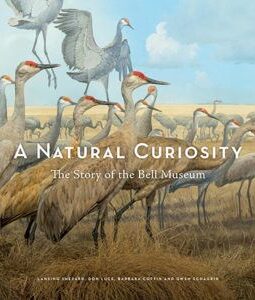A Natural Curiosity: The Story of the Bell Museum

- Year
- 2022
- Creators
- Reviewer: Anne Field
- Topics
A Natural Curiosity: The Story of the Bell Museum
Lansing Shepard, Don Luce, Barbara Coffin, and Gwen Schagrin
Minneapolis, MN: University of Minnesota Press, 2022
400 pages; cloth cover/jacket, 310 color plates, $34.95
The Bell Museum, located on the edge of the University of Minnesota’s St. Paul campus, is celebrating its 150th anniversary with A Natural Curiosity: The Story of the Bell Museum, a book that fondly recounts the museum’s history yet acknowledges its shortcomings. What could have been a dry chronology trumpeting the efforts of mainly white males is, instead, an honest account of the origins of the Bell, its challenges over the years, and its relevance today. The authors’ honesty and humility give ballast to A Natural Curiosity. It’s more than just an anniversary book. It’s an admirable yet unflinching history of how the Bell began and how it has survived. Nature is always changing and so is the Bell Museum.
In 1872, the Minnesota State Legislature mandated a geological and natural history survey of the state and created a natural history museum. So began the winding road of the Bell. The book’s strength is that it is not a strict chronology of the events of the past century and a half but rather a collection of stories featuring the many characters who built the Bell. A reader may pick up this book, open to any page, and enjoy anecdotes and photos of people whose work was significant to the institution. Early on, there is a multipage timeline of the museum’s history that allows the reader to interact with random curiosity, moving easily back and forth through the pages while remaining oriented.
One of the museum’s objectives has always been to raise public awareness of the natural world and conservation. Many of us will never see the sandhill crane migration or John James Audubon’s enormous The Birds of America folio in person, but, in A Natural Curiosity, a reader may study beautiful color reprints of the museum’s dioramas and selected plates from Audubon’s tome. This new publication is rich in content, and the style of the writing is conversational, instructive, and accessible to a range of ages and backgrounds.
Given the era in which the Bell originated, its hallmark was its dioramas. A diorama or habitat group of animals was a new way to represent nature in museums in the early twentieth century. Animals were preserved through taxidermy and arranged in an ecological setting in a glass display. The walls of the displays featured exquisitely painted natural settings. This book devotes many pages to the artistry and scope of these dioramas. The organization’s goal was to provide the public with “windows into nature,” but, by the 1940s, dioramas had fallen from favor. Viewers had other venues through which to experience wildlife, and questions were raised about how much people learned from dioramas. Rather than destroy them, the Bell dioramas were lovingly and expertly refurbished, treated as works of art from a bygone era, corrected to better represent history as we understand it today, and incorporated into the museum’s new location on the St. Paul campus.
The book touches on the temporary decline of the institution in the mid-twentieth century, while acknowledging the many people whose dedication kept its original spirit and purpose alive. Scientists were in the field studying environmental change, biodiversity, and human impact. More women entered the sciences, and artists of diverse backgrounds were recognized for their abilities to enhance study of the natural world in innovative and creative ways. Bell Museum curators led the way nationally in using digital media to catalog, manage, and make accessible the museum’s vast specimen collections. Slowly, the Bell reinvented itself, embracing technology, collaboration, and social change. Throughout the book, it is clear that this isn’t just a building or an institution, rather, people have made the Bell what it is today.
A Natural Curiosity traces the Bell Museum’s journey from its ambitious beginnings to near neglect and back to a valued place in our state’s history. The book is balanced and clear-eyed, both a recognition of growth and achievement and an acknowledgement of the inequities upon which the museum was built. The book is, indeed, a celebration of the Bell and, just like the museum itself, it is open to all.
Anne Field is a community volunteer and serves on the board of the Ramsey County Historical Society. She is chair of their editorial board.
- Year
- 2022
- Creators
- Reviewer: Anne Field
- Topics